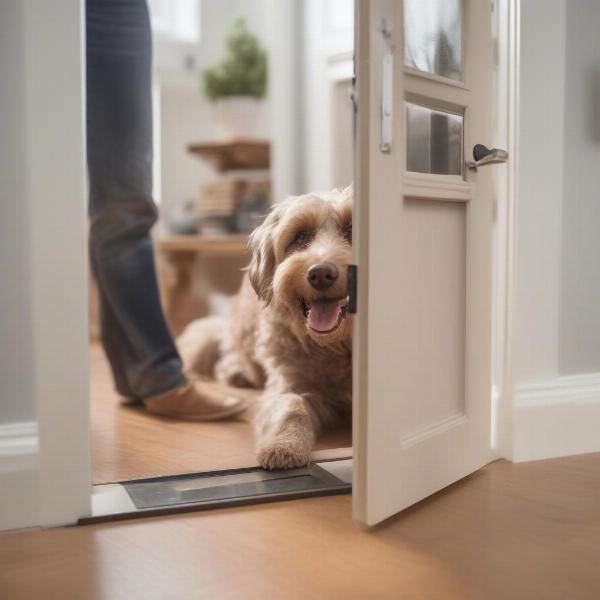Choosing the right pet door can significantly improve your dog’s quality of life, offering them greater independence and easier access to the outdoors. This guide explores various aspects of pet doors for dogs, covering everything from choosing the right size and type to installation and training. Whether you’re considering a pet door for a small puppy or a large senior dog, we’ll provide you with the information you need to make the best decision for your furry friend.
Choosing the Right Pet Door Size
One of the most crucial factors to consider when selecting a pet door is the size. A properly sized door will allow your dog to comfortably pass through without stooping or squeezing. Measure your dog’s height from the top of their shoulders to the bottom of their chest and their width at the widest point of their chest. Choose a pet door that is slightly larger than these measurements to ensure a comfortable fit. Consider also the step-over height, particularly for smaller dogs or senior dogs with mobility issues.
Different Types of Pet Doors
Pet doors come in a variety of styles, each designed for specific needs and installation locations. Common types include:
- Wall-mounted pet doors: Ideal for installing directly into an exterior wall, providing flexibility in placement.
- Door-mounted pet doors: A more affordable and easier-to-install option, these doors fit into an existing door.
- Sliding door pet doors: Designed for sliding patio doors, these often involve replacing a section of the sliding panel.
- Electronic pet doors: Offer increased security and control, often activated by a microchip on your dog’s collar.
Each type has its own set of advantages and disadvantages, so consider your home’s layout and your dog’s needs when choosing.
Installation Tips for Pet Doors
While some pet doors are designed for easy DIY installation, others might require professional help. Always follow the manufacturer’s instructions carefully. For wall-mounted doors, ensure you choose a location that is structurally sound and avoids any wiring or plumbing. For door-mounted doors, measure carefully to ensure a proper fit.
Training Your Dog to Use a Pet Door
Introducing your dog to their new pet door should be a gradual process. Start by holding the flap open and encouraging your dog to walk through with treats and positive reinforcement. Gradually lower the flap until your dog is comfortable pushing it open themselves. Be patient and consistent, and your dog will soon be using their pet door with confidence.
 Training a dog to use a pet door using treats and positive reinforcement
Training a dog to use a pet door using treats and positive reinforcement
Benefits of Pet Doors for Dogs
What are the advantages of having a pet door? A pet door offers several benefits:
- Increased Independence: Allows your dog to go outside as needed, promoting potty training and reducing accidents.
- More Exercise: Encourages your dog to be more active, improving their physical and mental health.
- Convenience for Owners: Eliminates the need to constantly let your dog in and out, especially useful for busy owners.
Pet Doors for Specific Breeds and Sizes
Do you have a small dog or a large breed? Choosing a pet door that is appropriately sized for your dog’s breed and individual size is crucial for their comfort and safety. While there are standard sizes available, some manufacturers offer custom-sized options for larger or unusually shaped dogs.
Pet Doors and Security Concerns
Are you worried about security? While pet doors offer many advantages, some owners are concerned about security. Electronic pet doors, activated by a microchip or collar sensor, offer enhanced security, preventing unwanted animals from entering your home.
Conclusion
Pet doors provide a valuable addition to any dog-loving home, offering both convenience and increased independence for your canine companion. By carefully considering the size, type, and installation requirements, you can choose the perfect pet door for your dog and your home.
FAQ
- What size pet door do I need for my dog? Measure your dog’s height and width at the widest point of their chest and choose a door slightly larger than those measurements.
- Are pet doors secure? While standard pet doors can pose a security risk, electronic pet doors offer enhanced security features.
- How do I train my dog to use a pet door? Start by holding the flap open and encouraging your dog to walk through with treats. Gradually lower the flap until they are comfortable pushing it open themselves.
- Can I install a pet door myself? Some pet doors are designed for DIY installation, while others require professional help. Always follow the manufacturer’s instructions.
- What type of pet door is best for my sliding glass door? Look for pet doors specifically designed for sliding glass doors, often involving replacing a section of the sliding panel.
- Are there pet doors for very large dogs? Yes, several manufacturers offer extra-large pet doors or custom-sized options for larger breeds.
- What is the best material for a pet door? Durable materials like aluminum and reinforced plastic are ideal for pet doors, offering weather resistance and security.
ILM Dog is a leading international pet website dedicated to providing expert advice on dog care and wellbeing. We offer comprehensive resources on dog breeds, health, training, nutrition, grooming, and much more. From puppy care to senior dog care, we’re here to support you every step of the way. For expert advice tailored to your specific needs, reach out to our team. Email: [email protected] Phone: +44 20-3965-8624. Visit ILM Dog for more valuable information.